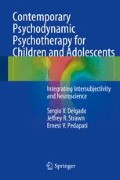Abstract
We open this chapter with Freud’s masterful quote that captures the role children have as active participants in their development. For many years, infants were thought of as being dependent and unaware of the world around them (Mahler et al., Symbiosis and individuation: the psychological birth of the human infant. Basic Books, New York, 1975). The work by early developmental researchers—including Bowlby, Spitz, Emde, Stern, etc.—helped elucidate that infants were hardwired to develop complex abilities for social reciprocity, and if raised by parents with “good enough” capacities for affective attunement, the infants were quite busy in meaning-making processes. Tronick and Beeghly (Am Psychol 66(2):107–119, 2011) state, “In developing systems, such as human infants, sufficient resources must be obtained to enable them to increase their coherence and complexity and to self-organize new capacities.” Further, Bretherton and Munholland ’s (Internal working models in attachment relationships: a construct revisited. In: Cassidy J, Shaver PR (eds) Handbook of attachment: theory, research, and clinical applications. Guilford Press, New York, 1999) work reinforced the notion that interactions between infants and their parents gave meaning to their shared experiences, with the development of internal working models of attachment giving coherence to their relationships. When infants have emotionally available and affectively attuned parents, they develop secure working models in relating with others. When parents provide a secure base for the infant, it increases the likelihood of the infant acquiring the emotional resources needed in the short run, and in the long run, these growth-promoting social interactions will contribute to self-regulatory capacities and resiliency. Over time, infants become part of a larger and more complex system, and they become more flexible and better able to reorganize when confronted by day-to-day discontinuities in their care.
Every child at play behaves like a creative writer, in that he creates a world of his own, or, rather, rearranges the things of his world in a new way which pleases him.
—Sigmund Freud
Access this chapter
Tax calculation will be finalised at checkout
Purchases are for personal use only
References
Andersen SL (2003) Trajectories of brain development: point of vulnerability or window of opportunity? Neurosci Biobehav Rev 27(1–2):3–18
Beeghly M, Cicchetti D (1994) Child maltreatment, attachment, and the self system: emergence of an internal state lexicon in toddlers at high social risk. Dev Psychopathol 6:5–30
Beeghly M, Tronick E (2011) Early resilience in the context of parent-infant relationships: a social developmental perspective. Curr Probl Pediatr Adolesc Health Care 41(7):197–201
Bretherton I, Munholland KA (1999) Internal working models in attachment relationships: a construct revisited. In: Cassidy J, Shaver PR (eds) Handbook of attachment: theory, research, and clinical applications. Guilford Press, New York
Cicchetti D, Barnett D (1991) Attachment organization in maltreated preschoolers. Dev Psychopathol 3:397–411
Daws D (1993) Feeding problems and relationship difficulties: therapeutic work with parents and infants. J Child Psychother 19:69–83
Delgado SV, Emde RN, Pope KK (1993) An atypical eating disorder in a 2-year-old female. Bull Menninger Clin 57(2):242–251
Emde RN, Harmon RJ (1984) Continuities and discontinuities in development. Plenum, New York
Fraiberg S, Adelson E, Shapiro V (1975) Ghosts in the nursery. A psychoanalytic approach to the problems of impaired infant-mother relationships. J Am Acad Child Psychiatry 14(3):387–421
Fraley RC, Shaver PR (2000) Adult romantic attachment: theoretical developments, emerging controversies, and unanswered questions. Rev Gen Psychol 4:132–154
Freud A (1974) Normality and pathology in childhood: assessments of development, vol 6. International Universities Press, New York
Gottlieb G, Halpern CT (2008) Individual development as a system of co-actions: implications for research and policy. In: Fogel A, King BJ, Shanker SG (eds) Human development in the 21st century. Cambridge University Press, New York
Kagan J (1998) Three seductive ideas. Harvard University Press, Cambridge
Mahler MS, Pine F, Bergman A (1975) Symbiosis and individuation: the psychological birth of the human infant. Basic Books, New York
Nelson CA, Zeanah CH, Fox NA (2007) The effects of early deprivation on brain-behavioral development: the Bucharest early intervention project. In: Romer D, Walker EF (eds) Adolescent psychopathology and the developing brain: integrating brain and prevention science. Oxford University Press, New York
Pearson RM, Evans J, Kounali D et al (2013) Maternal depression during pregnancy and the postnatal period: risks and possible mechanisms for offspring depression at age 18 years. J Am Psychiatry 70(12):1312–1319
Petrucelli J (2010) Knowing, not-knowing and sort of knowing: psychoanalysis and the experience of uncertainty. Karnac, London
Rustin J, Sekaer C (2004) From the neuroscience of memory to psychoanalytic interaction. Psychoanal Psychol 21:70–82
Salomonsson B (2012) Has infantile sexuality anything to do with infants? Int J Psychoanal 93:631–647
Sander L (2004) Living systems, evolving consciousness, and the emerging person. Analytic Press, New York
Sroufe LA (2009) The concept of development in developmental psychopathology. Child Dev Perspect 3:178–183
Tamis-LeMonda CS, Bornstein MH, Baumwell L et al (1996) Responsive parenting in the second year: specific influences on children’s language and play. Early Dev Parenting 5:173–183
Tronick E, Beeghly M (2011) Infants’ meaning-making and the development of mental health problems. Am Psychol 66(2):107–119
Author information
Authors and Affiliations
Rights and permissions
Copyright information
© 2015 Springer-Verlag Berlin Heidelberg
About this chapter
Cite this chapter
Delgado, S.V., Strawn, J.R., Pedapati, E.V. (2015). Two-Person Relational Psychotherapy: Infants and Preschool Age Children. In: Contemporary Psychodynamic Psychotherapy for Children and Adolescents. Springer, Berlin, Heidelberg. https://doi.org/10.1007/978-3-642-40520-4_10
Download citation
DOI: https://doi.org/10.1007/978-3-642-40520-4_10
Published:
Publisher Name: Springer, Berlin, Heidelberg
Print ISBN: 978-3-642-40519-8
Online ISBN: 978-3-642-40520-4
eBook Packages: MedicineMedicine (R0)

